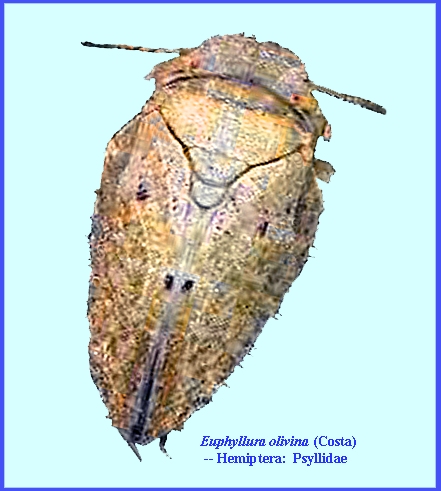File: <olivepsyllid > Pooled References GENERAL
INDEX [Navigate to MAIN MENU ]
|
Olive Psyllid Euphyllura
olivina (Costa) --
Hemiptera: Psyllidae |
------ CLICK on photo to enlarge. To search for Subject Matter, Depress Ctrl/F
----------------------------------------------------------------------------------------------------------------------------------
|
There
are three host plants that serve as hosts: a) olive; b) Russian olive (Elaeagnus angustifolia [oleaster]), and
c) mock privet (Phillyrea latifolia). Three generations usually occur per
year. The first generation becomes
active in the spring as temperatures warm up. The second generations when temperatures exceed 81 deg.
Fahrenheit, and active again when temperatures drop giving rise to the third
generation. Nymphs and adults feed by
rupturing cells and ingesting sap.
Plant parts attacked include the buds, tender shoots, floral axes,
inflorescences, and young fruits.
Nymphs secrete a sticky wax substance that accumulates on the foliage
and causes premature flower drop. The
wax actually protects the psyllid from some insecticides so it is best to
control the first generation when buds and flowers are not present. Nymphs and adults produce honeydew, which
can attract sooty mold. When colonies
are on inflorescences, the level of sap loss depends on psyllid numbers and
this would affect the amount of fruit that is set. REFERENCES:
FURTHER RELATED REFERENCES Asadi, R.; A. A. Talebi, D. Burckhardt,, J. Khalgani, Y. Fathipour,
& Mohar Ramipour. 2009. On the identity of the olive psyllids in
Iran (Hemiptera, Psylloidea). Mitteilungen der Schweizerischen Entomologischen
Gesellschaft, 82: 197–200. Costa,
O. G. 1839. Monografia degl’ insetti ospitanti sull’ ulivo e nelle olive.
In O. G. Costa (Ed.), Corrispondenza zoologica destinata a diffondere nel
regno delle Due Sicilie tutto cio che si va discuoprendo entro e fuori Europa
(e vice versa) risguardante la zoologia in generale. pp. 91–136 in Azzolino e Compagno. El-Khawas, M. A.; A. H. El-Heneidy,
H. Aziza, E. Omar & H.
El-Sherif. 2000. A recent record of parasitoids on common
olive pests in Egypt. Scientific Note.
Egypt. J. Biol. Pest Cont. 10 (2):
137-138. Hougardy, E.; X. Wang, B. N. Hogg, M. W. Johnson, K. M.
Daane & C. H. Pickett.
2020. Current distribution of
the olive psyllid, Euphyllura olivina,
in California and initial evaluation of the Mediterranean parasitoid Psyllaephagus euphyllurae as a
biological control candidate. Insect, 11:
146. Johnson, M. W., K. M. Daane & K.
Lynn-Patterson. 2010. Appraising the threat of olive psyllid to
California table olives. In:
M. W. Johnson (Ed.), Final and
interim research reports pp. 1–11, California Olive Committee. Martoni, F., S. Bulman, A. Pitman, G.
Taylor & K. Armstrong. 2018. DNA barcoding
highlights cryptic diversity in the New Zealand Psylloidea (Hemiptera:
Sternorrhyncha). Diversity, 10: 50. Ouvrard, D.
2020. Psyllist – The World
Psylloidea Database. http://www.hemiptera-databases.com/psyllist. Chiappini, E., S. V. Triapitzin & A. Donev. 1996.
Key to the Holarctic species of Anagrus
Haliday (Hymenoptera: Mymaridae) with a review of the Nearctic and
Palaearctic (other than European) species and descriptions of new taxa. Journal of Natural History 30: 551-595. Triapitzin,
S. V. 1995a. The identities of Anagrus (Hymenoptera: Mymaridae) egg
parasitoid of the grape and blackberry leafhoppers (Homoptera: Cicadellidae)
in California. Pan-Pacific Entomol.
71 (4): 250-251. Triapitzin, S. V. 1995b. A review of the Australian species of Anagrus (Hymenoptera: Mymaridae). Russian Entomological Journal 4
(1-4): 105-108. Triapitzin, S.
V. 1997. The genus Anagrus
(Hymenoptera: Mymaridae) in America south of the United States: a
review. Ceiba (Zamorano,
Honduras) 38 (1): 1-12. Triapitzin, S.
V. 1998. Anagrus
(Hymenoptera: Mymaridae) egg parasitoids of Erythroneura
spp. and other leafhoppers (Homoptera: Cicadellidae) in North American
vineyards and orchards: a taxonomic review.
Transactions of the American Entomological Society. 124 (2): 77-112. Triapitzin, S. V., R. F. Mizell, J. L. Bossart & C. E.
Carlton. 1998. Egg parasitoids of Homalodisca coagulata (Homoptera:
Cicadellidae). Florida Entomologist 81
(2): 241-243. Triapitzin, S. V. & D. Strong.
1995. A new Anagrus (Hymenoptera: Mymaridae), an egg
parasitoid of Prokelisia spp. (Homoptera:
Delphacidae). Pan-Pacific Entomol. 71 (4):
199-203. Walker, G. P.,
N. Zareh, I. M. Bayoun & S. V. Triapitzin. 1997.
Introduction of western Asian egg parasitoids into California for
biological control of beet leafhopper, Circulifer
tenellus. Pan-Pacific Entomologist 73 (4): 236-242. |
